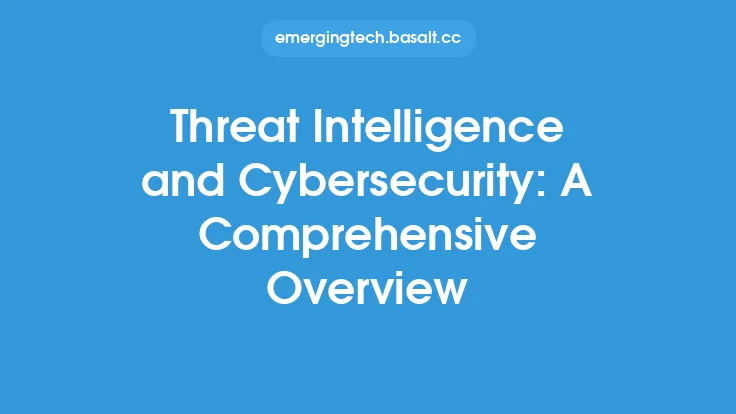The world of cybersecurity is becoming increasingly complex, with new threats and vulnerabilities emerging every day. As a result, organizations are looking for ways to stay ahead of these threats and protect their networks, systems, and data. One approach that has gained significant attention in recent years is threat intelligence. Threat intelligence involves collecting, analyzing, and disseminating information about potential or actual cyber threats, allowing organizations to make informed decisions about their cybersecurity posture. In this article, we will delve into the world of threat intelligence, exploring its concepts, benefits, and applications, as well as the technical aspects of implementing a threat intelligence program.
What is Threat Intelligence?
Threat intelligence is the process of gathering, analyzing, and disseminating information about potential or actual cyber threats. This information can come from a variety of sources, including open-source intelligence, social media, dark web forums, and human intelligence. The goal of threat intelligence is to provide organizations with a comprehensive understanding of the threats they face, allowing them to make informed decisions about their cybersecurity strategy. Threat intelligence can be categorized into several types, including strategic, tactical, and operational intelligence. Strategic intelligence provides a high-level overview of the threat landscape, while tactical intelligence focuses on specific threats and vulnerabilities. Operational intelligence, on the other hand, provides real-time information about ongoing attacks and incidents.
Benefits of Threat Intelligence
The benefits of threat intelligence are numerous. By providing organizations with a comprehensive understanding of the threats they face, threat intelligence allows them to make informed decisions about their cybersecurity strategy. This can include prioritizing vulnerabilities, allocating resources, and implementing countermeasures. Threat intelligence can also help organizations to reduce their risk exposure, improve their incident response, and enhance their overall cybersecurity posture. Additionally, threat intelligence can provide organizations with a competitive advantage, allowing them to stay ahead of their competitors and protect their intellectual property.
Threat Intelligence Lifecycle
The threat intelligence lifecycle consists of several stages, including planning and direction, collection, analysis, dissemination, and feedback. The planning and direction stage involves defining the scope and objectives of the threat intelligence program, as well as identifying the sources of information and the tools and techniques to be used. The collection stage involves gathering information from various sources, including open-source intelligence, social media, and dark web forums. The analysis stage involves examining the collected information to identify patterns, trends, and anomalies. The dissemination stage involves sharing the analyzed information with stakeholders, including security teams, management, and law enforcement. The feedback stage involves continuously evaluating and improving the threat intelligence program, based on feedback from stakeholders and the effectiveness of the program.
Technical Aspects of Threat Intelligence
From a technical perspective, threat intelligence involves the use of various tools and techniques to collect, analyze, and disseminate information about potential or actual cyber threats. This can include the use of threat intelligence platforms, which provide a centralized repository for threat data and analytics. These platforms can be used to collect and analyze information from various sources, including network traffic, system logs, and threat feeds. Additionally, threat intelligence involves the use of machine learning and artificial intelligence to analyze large datasets and identify patterns and anomalies. This can include the use of techniques such as clustering, decision trees, and neural networks to identify and classify threats.
Threat Intelligence Feeds
Threat intelligence feeds are an essential component of any threat intelligence program. These feeds provide a continuous stream of information about potential or actual cyber threats, allowing organizations to stay up-to-date with the latest threats and vulnerabilities. Threat intelligence feeds can be categorized into several types, including IP reputation feeds, domain reputation feeds, and malware feeds. IP reputation feeds provide information about the reputation of IP addresses, including whether they have been associated with malicious activity. Domain reputation feeds provide information about the reputation of domains, including whether they have been associated with phishing or malware. Malware feeds provide information about the latest malware threats, including their characteristics, behavior, and mitigation strategies.
Implementing a Threat Intelligence Program
Implementing a threat intelligence program requires a structured approach, involving several stages, including planning, collection, analysis, dissemination, and feedback. The planning stage involves defining the scope and objectives of the program, as well as identifying the sources of information and the tools and techniques to be used. The collection stage involves gathering information from various sources, including open-source intelligence, social media, and dark web forums. The analysis stage involves examining the collected information to identify patterns, trends, and anomalies. The dissemination stage involves sharing the analyzed information with stakeholders, including security teams, management, and law enforcement. The feedback stage involves continuously evaluating and improving the program, based on feedback from stakeholders and the effectiveness of the program.
Challenges and Limitations
Despite the benefits of threat intelligence, there are several challenges and limitations to implementing a threat intelligence program. One of the main challenges is the sheer volume of data that needs to be collected and analyzed, which can be overwhelming for many organizations. Additionally, the quality of the data can be a major concern, as inaccurate or incomplete information can lead to incorrect conclusions and decisions. Furthermore, the lack of standardization in threat intelligence can make it difficult to compare and contrast different sources of information. Finally, the cost of implementing a threat intelligence program can be prohibitively expensive for many organizations, particularly small and medium-sized businesses.
Best Practices
To get the most out of a threat intelligence program, there are several best practices that organizations should follow. First, organizations should define a clear scope and objectives for the program, including what types of threats to focus on and what sources of information to use. Second, organizations should use a combination of automated and manual analysis techniques to examine the collected information and identify patterns, trends, and anomalies. Third, organizations should disseminate the analyzed information to stakeholders in a timely and effective manner, using clear and concise language. Fourth, organizations should continuously evaluate and improve the program, based on feedback from stakeholders and the effectiveness of the program. Finally, organizations should consider using threat intelligence platforms and feeds to streamline the collection, analysis, and dissemination of threat data.
Conclusion
In conclusion, threat intelligence is a critical component of any cybersecurity strategy, providing organizations with a comprehensive understanding of the threats they face and allowing them to make informed decisions about their cybersecurity posture. By understanding the concepts, benefits, and applications of threat intelligence, as well as the technical aspects of implementing a threat intelligence program, organizations can stay ahead of emerging threats and protect their networks, systems, and data. While there are several challenges and limitations to implementing a threat intelligence program, following best practices and using the right tools and techniques can help organizations to overcome these challenges and get the most out of their threat intelligence program.





